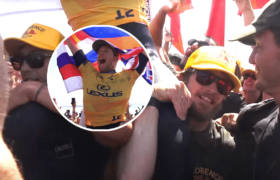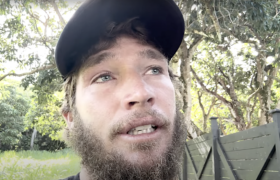Every single wave exposed on film becomes a surf ghetto. True or true?
How about this absolute truth? Every single wave revealed for the first time on film has become a surf ghetto. Don’t matter how good you hide where it is. No exceptions.
Count ’em: Bali. The Mentawais. Namibia. Hossegor. Morocco. Fiji. Puerto Escondido. Overrun with sonsofbitches in their so-called “camps” with nothing else to talk about except waves ridden, how many seconds behind the curtin they’re logging and where their next tubefest is going to be.
You show a good wave. People are gonna find it.
So any sort of concern that Mick’s empty sandbottom point, which blew up three days ago, might get exposed is a dazzling naivety.
Of course it will.
Just as Rip Curl’s beautifully produced Search films in the nineties brought the world to the Ments, and all those P-Pass photos and clips had us chasing a difficult-to-get-to reef in Micronesia, Mick’s clip has just opened a new gate.
First, the explorers will come. Then, the tour guides. Then, you and me.
Watching the lights flash all over that empty point reminded me of another wave The Search illuminated. Do you remember when The Rip Curl Search Pro went to Barra de la Cruz or, as it was coyly named, “La Jolla”, in 2006?
It was the surf contest that affirmed everything good about the game. An impossibly perfect sandbottom point most people had no idea existed. Professionals who’d been everywhere calling it the best wave they’d ever surfed, the best contest ever. Best-evers dripping through the floor. Andy Irons, who won the event, nailing the biggest frontside air in competition. The longest tubes seen in an event since Kirra was a thing.
The world watched the live webcast with mouths agape.
The contest rewrote the expectation of what a perfect wave might look like. It’s doubtful there was a regular footer on earth who didn’t make kind of vague plan to ride the joint before they expired.
And, soon, the crowds arrive at the little town mid-way between Puerto Escondido and Salina Cruz. The council built a cabana and bathrooms on the beach for the influx of visitors. The coastal road was gated and an entry fee levied.
Tourism. Jobs. Money. Who could argue with the capitalist ideal of the free market bringing wealth to the poor?
And then it went to shit.
Why?
As Surfer Magazine’s Kimball Taylor wrote in 2015,
Citizens were becoming proud of their little town. The beach cabaña evolved into a symbol of their new economy. So when not long after the contest the historically wild river mouth that emptied near the point began to threaten the cabaña with erosion, Barra’s council decided to move the entire river to the east. According to a local surfer named Cesar, this is when sand began to disappear from the break. The river, Cesar indicated in hindsight, was the source of the wave’s magic. Without a periodic infusion of river sand, a hole soon began to develop in the sandbar. A tropical cyclone exacerbated the situation, and by 2010 the most phenomenal sand point the pro tour had ever seen was a shadow of its former self.
The town council, meanwhile, citing the prohibitive expense of the cabaña, refused to return the river to its original course.
Visiting surfers would show up, take a look at the wounded pointbreak, and head down to the newest surf-world hotspot: Salina Cruz.
Tourism business disappeared as steadily as the sand.
A wave found. A wave celebrated. A wave ruined.
Where to, you think, for Mick’s Point?








